|
|

|
|

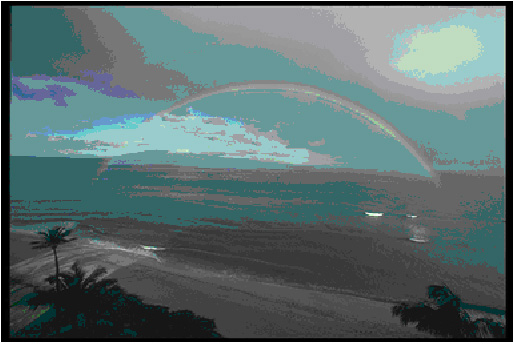
Rainbows can be explained by what you have already learned about refraction, reflection, and dispersion and some geometry. Rainbows are seen when the sun is over the viewer's back and with the sunlight being passing through a mist of tiny spherical water droplets. Figure 17.4 illustrates what happens when a ray of light enters a spherical drop of water. There, it is refracted at the front surface, reflected inside at the back surface, and refracted again as it exits the front surface. The details of this figure explain the formation of the colors of a rainbow.
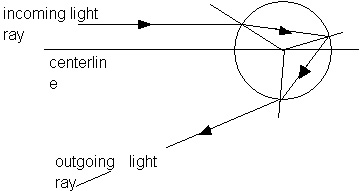
If we look at light rays that come into a spherical water droplet at varying distances from the centerline, we will find that some of the rays are scattered through 180o,entirely back scattered. Other rays will be scattered less but there is a minimum scattering angle of about 138o as shown in Figures 17.5 and 17.6. That means the angle between the incident light and the scattered light will be 42o (42o = 180o - 138o). In fact, most of the light will be scattered at an angle very close to this as shown in Figure 17.7.
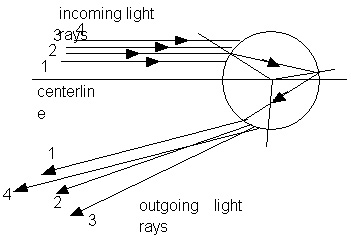
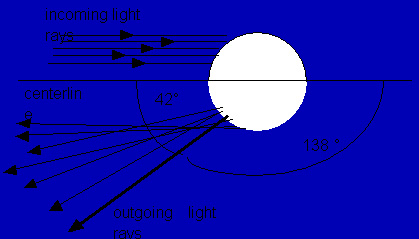
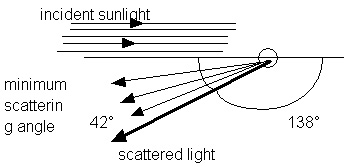
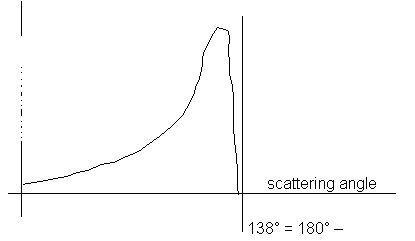
Figure 17.8 shows what an observer would see with the Sun over her back and sunlight incident on a mist of tiny water droplets. Most of the light will be scattered through about 138o, with an angle of 42o between the incoming and scattered light. This will produce a bright arc or ring or "bow" with an angle of 42o between the center of this bow and the bow as measured by the observer as sketched in the figure. Some light will be scattered through angles greater than 138o so this light will be seen inside the bow, making this region brighter. No light will be scattered through angles smaller than 138o so no light will be scattered outside the bow, making this region dark.
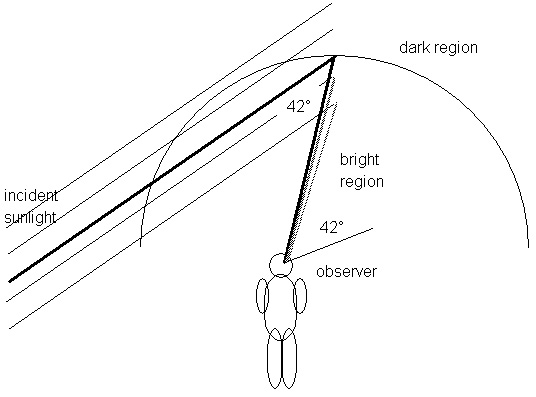
This description is the beginning of explaining a rainbow but no mention has yet been made concerning colors. You will recall that the index of refraction depends upon the color or wavelength of light; this is known as dispersion. This is easy to see when light passes through a prism. The same thing happens when white sunlight, which contains all wavelengths or colors of light, passes through a water droplet. As sketched in Figure 17.9, violet light will be scattered through a greater angle than red light. Violet and red are the extremes of the visible range. We will concentrate our attention on these extremes, knowing that all the other colors will be found at angles between violet and red.
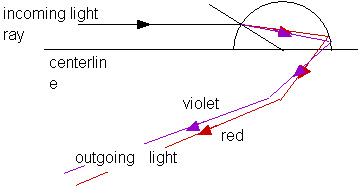
Figure 17.10 is much like Figure 17.8, showing what an observer sees as sunlight is scattered by a mist of water droplets, but now we are including the difference in angles through which light of different colors is scattered. While we can sketch in all the rays of light we want, remember than an observer only sees by the rays of light that actually enter her eye. As shown in the figure, rays of red light from a slightly higher droplet and rays of violet from a slightly lower droplet enter the observer's eye together. This means the observer sees red light coming from slightly higher in the sky than the violet light. The upper or outside edge of the rainbow that is seen will be red and the lower or inside edge of the rainbow will be violet with all the other colors in between. The region inside the rainbow will be bright because some light from even lower droplets is scattered into the observer's eye. The region outside the rainbow will be dark because no light from droplets above the red will be scattered into the observer's eye.
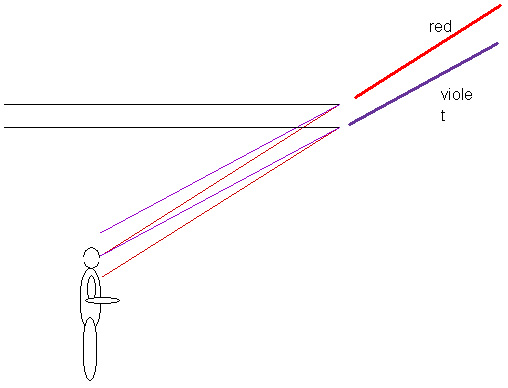
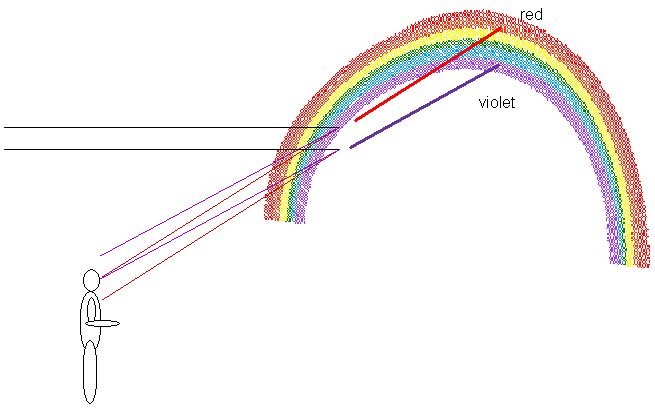
Sometimes, if the conditions are just right, a second rainbow may be seen outside the usual one. This secondary rainbow is fainter than the primary rainbow and the colors are reversed in order. The sky will be bright outside this secondary rainbow and the region between the two rainbows will be dark. Such a double rainbow is shown in Figure 17.11. The secondary rainbow is the result of light that has been reflected twice inside the water droplet as sketched in Figure 17.12. Figure 17.13, much like Figures 17.8 and 17.10, shows what will be seen by an observer with the Sun over her back.
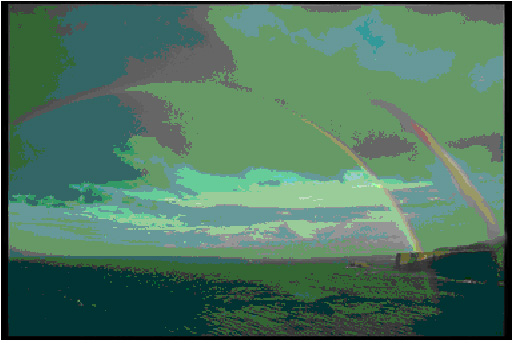
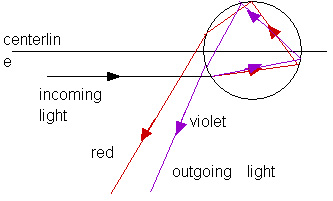
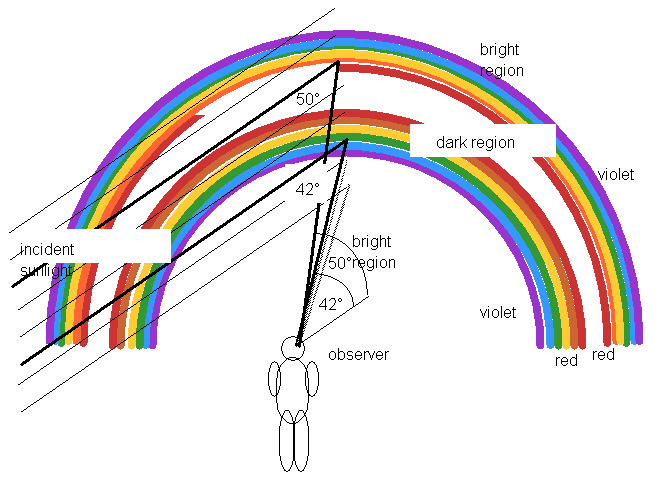
Essay
"My heart leaps up when I behold a rainbow in the sky: So it was when my life began; So it is now I am a man; So be it when I shall grow old, or let me die!"
These emphatic words by Wordsworth describe the way many have thought of rainbows for thousands of years.
Ever since Noah and the flood, people have been curious about rainbows. What do they mean? How are they formed? From fearful people to awestruck citizens, rainbows turn heads skyward. In fact, some of the myths people believed about rainbows are more interesting than the truth.
Irish legends speak of leprechauns and pots of gold hidden at the end of rainbows. While a nice big pot of gold would come in handy for anyone, especially for a poor college student, there is a problem. Rainbows appear to move as the observer does, so it is impossible to reach the end of a rainbow. Unfortunately, no one has ever gotten rich by finding the pot of gold at the end of the rainbow.
In medieval Germany, many believed that for forty years before the end of the world, no rainbows would appear. Thus, people were relieved to see a rainbow; as the saying goes: "So the rainbow appear, the world has no fear, until thereafter forty years."
Many cultures all over the world believed that rainbows led to God. Some tribes of North American Indians called the rainbow a "Pathway of Souls." In Japan, some refer to a rainbow as the "Floating Bridge of Heaven." In Hawaii and Polynesia, myths call the rainbow the "path to the upperworld." People in the Austrian Alps say righteous souls go to heaven via the rainbow. A myth of New Zealand said that dead chiefs went up a rainbow to the afterlife.
Rainbows have also been used to predict good hunting or sailing weather. "A rainbow in the eve: put thine head in the sheave, a rainbow in the morrow; go take thy bow, and arrow," told hunters that morning rainbows meant better weather was coming. "A rainbow in the morning is the sailor's warning; a rainbow at night is the sailor's delight," told sailors the same thing.
Other groups of people, though, were terrified of rainbows. Long ago, Zulus thought that a rainbow was an enormous supernatural serpent. They called these rainbows "snake bows" and believed that they came out after a rainfall to eat unsuspecting humans and cattle.
Throughout history, rainbows have been considered either very good luck or very bad luck. Some say it is bad luck if a rainbow's end rest on water. Others say it is good luck if the ends of the rainbow rest on land. Similarly, a rainbow that appears the day a child is born is considered good luck. On the other hand, in the past, Slavonic people believed that looking at the base of a rainbow would bring death. Others believed that pointing at the highest point of a rainbow would bring bad luck (anything from being struck by lightning to developing an ulcer to losing a finger).
Interestingly enough, although rainbows are scientifically explainable optical phenomena that occur when white light is refracted into its spectrum of colors, the dictionary still defines rainbows as Noah did: a symbol of hope.
Essay by Amy E. Davis
A: No, a single rainbow always has the colors of the spectrum spread out from violet on the inside through blue and green and yellow and orange to red on the outside.
A: Light is scattered inside the rainbow but no light is scattered outside.

|
|